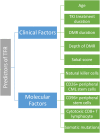Chronic Myeloid Leukemia, from Pathophysiology to Treatment-Free Remission: A Narrative Literature Review
- PMID: 37051025
- PMCID: PMC10084831
- DOI: 10.2147/JBM.S382090
Chronic Myeloid Leukemia, from Pathophysiology to Treatment-Free Remission: A Narrative Literature Review
Abstract
Chronic myeloid leukemia (CML) is one of the most common leukemias occurring in the adult population. The course of CML is divided into three phases: the chronic phase, the acceleration phase, and the blast phase. Pathophysiology of CML revolves around Philadelphia chromosome that constitutively activate tyrosine kinase through BCR-ABL1 oncoprotein. In the era of tyrosine kinase inhibitors (TKIs), CML patients now have a similar life expectancy to people without CML, and it is now very rare for CML patients to progress to the blast phase. Only a small proportion of CML patients have resistance to TKI, caused by BCR-ABL1 point mutations. CML patients with TKI resistance should be treated with second or third generation TKI, depending on the BCR-ABL1 mutation. Recently, many studies have shown that it is possible for CML patients who achieve a long-term deep molecular response to stop TKIs treatment and maintain remission. This review aimed to provide an overview of CML, including its pathophysiology, clinical manifestations, the role of stem cells, CML treatments, and treatment-free remission.
Keywords: chronic myeloid leukemia; remission; tyrosine kinase inhibitor.
© 2023 Rinaldi and Winston.
Conflict of interest statement
The authors report no conflicts of interest in this work.
Figures
References
-
- Sasaki K, Strom SS, O’Brien S, et al. Relative survival in patients with chronic-phase chronic myeloid leukaemia in the tyrosine-kinase inhibitor era: analysis of patient data from six prospective clinical trials. Lancet Haematol. 2015;2(5):e186–193. doi:10.1016/S2352-3026(15)00048-4 - DOI - PMC - PubMed
Publication types
LinkOut - more resources
Full Text Sources
Research Materials
Miscellaneous



